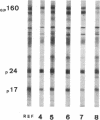Abstract
Evaluation of the immune response of individuals exposed to human immunodeficiency virus (HIV) is an important component of any plan designed to lead toward the development of an AIDS vaccine. Since the levels of antibodies to HIV p17 and the synthetic p17 peptide HGP-30 correlate with stages of progression to AIDS, studies were initiated to determine whether cytotoxic lymphocytes directed toward target cells pulsed with HGP-30 and radioactive chromium were present in seropositive individuals. The significance of such cells in controlling HIV viral infection has recently been enhanced by reports that HIV p17 is on the surface of infected cells and that an inactivated virus vaccine depleted of viral envelope appears to be effective in controlling expression. The selection of HGP-30 as the p17 peptide to be evaluated in early studies is based on the presence of both T-cell and B-cell epitopes as predicted by computer modeling and mouse studies and the demonstration of in vitro neutralization activity by antibodies to the epitope. By using B-lymphoblastoid cells pulsed with HGP-30 and radioactive chromium as autologous targets and mixed leukocyte culture-expanded peripheral blood lymphocytes as effectors, CD8+ cytotoxic T lymphocytes against HGP-30-coated targets were identified in seropositive individuals. In this report we demonstrate that a synthetic p17 epitope can be a target for major histocompatibility complex-restricted cytotoxic T lymphocytes in HIV-infected individuals.
Full text
PDF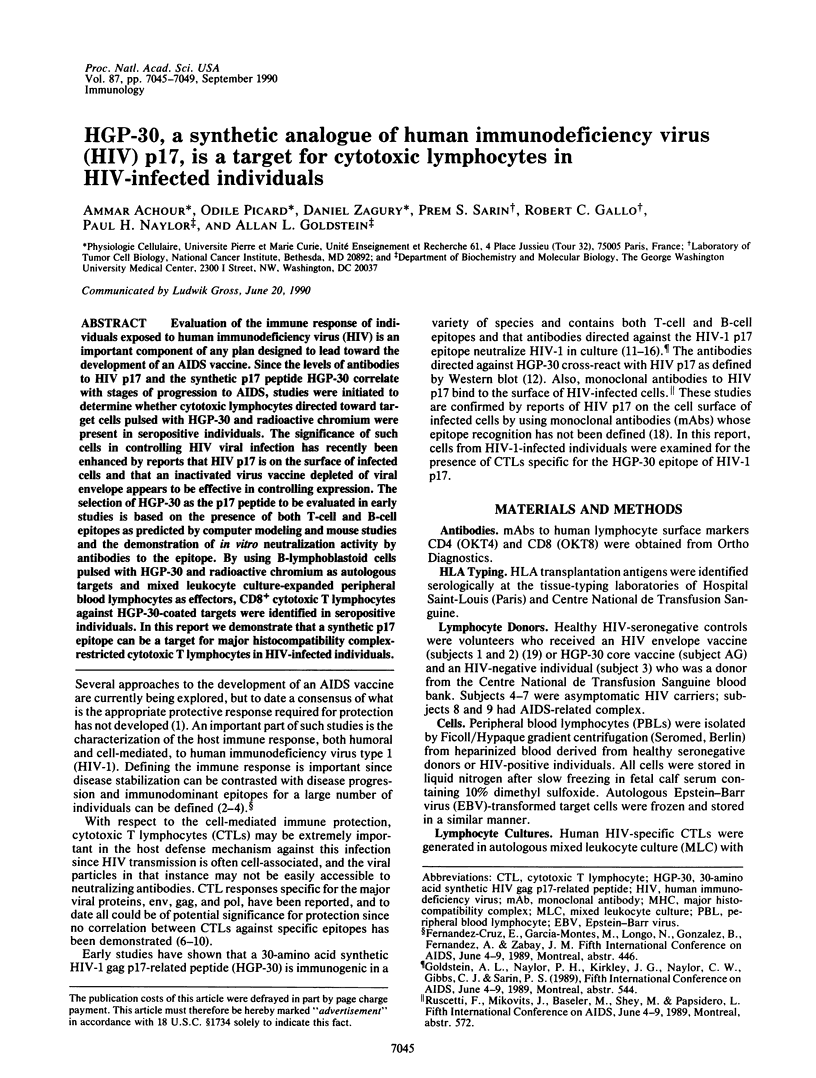
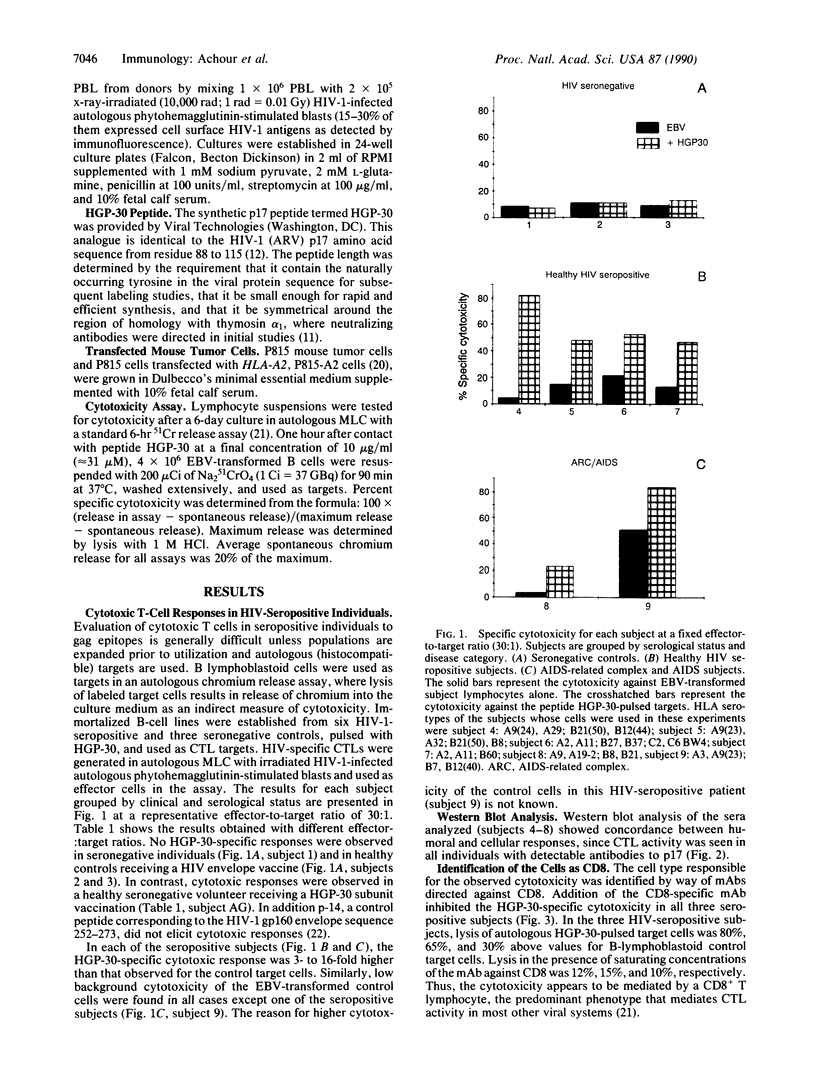
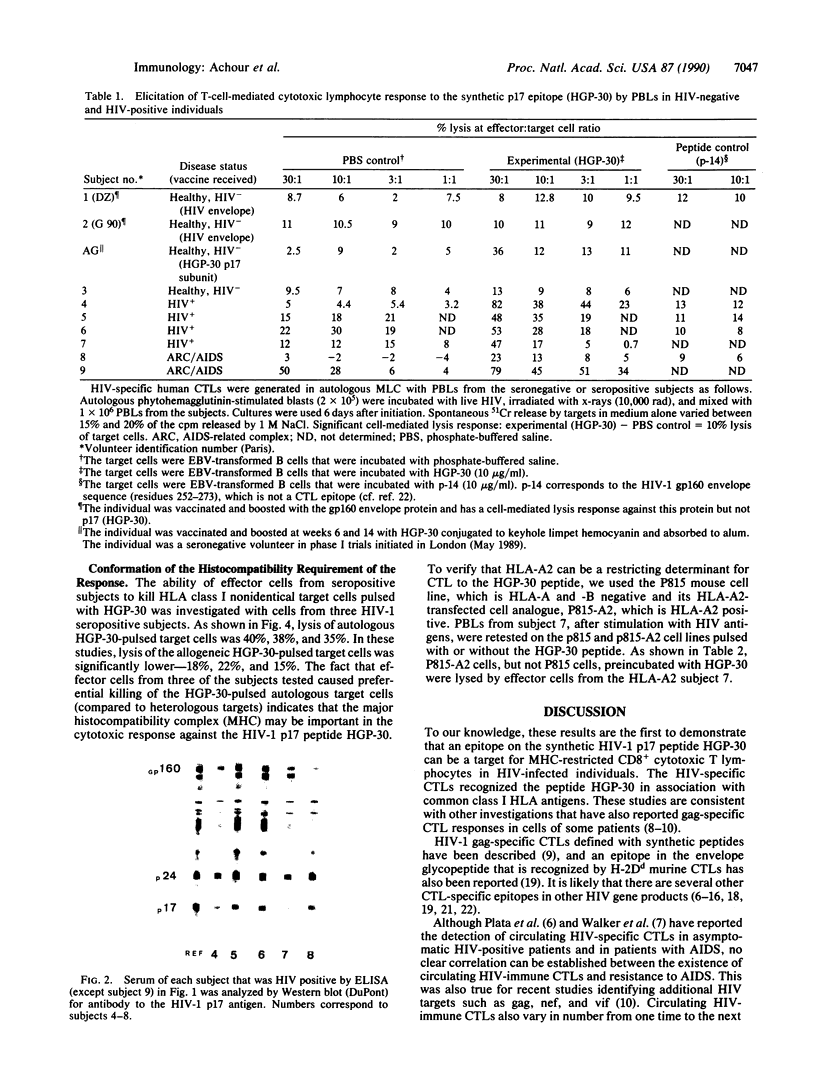
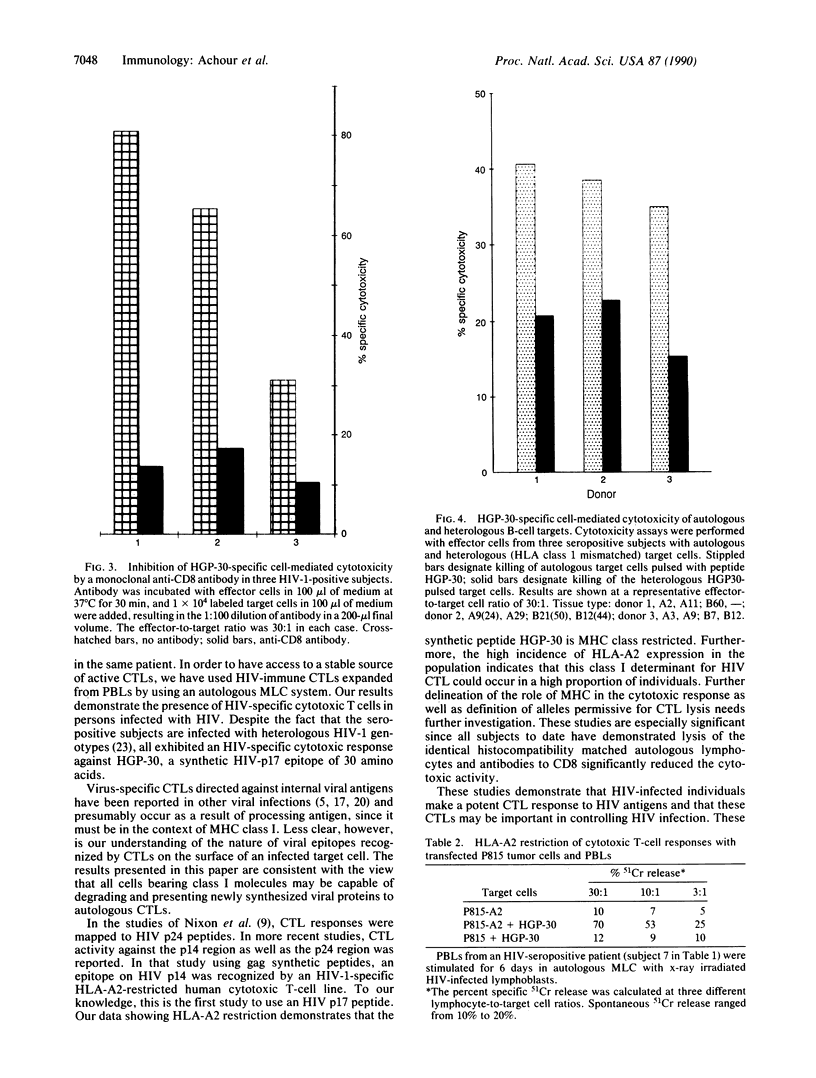
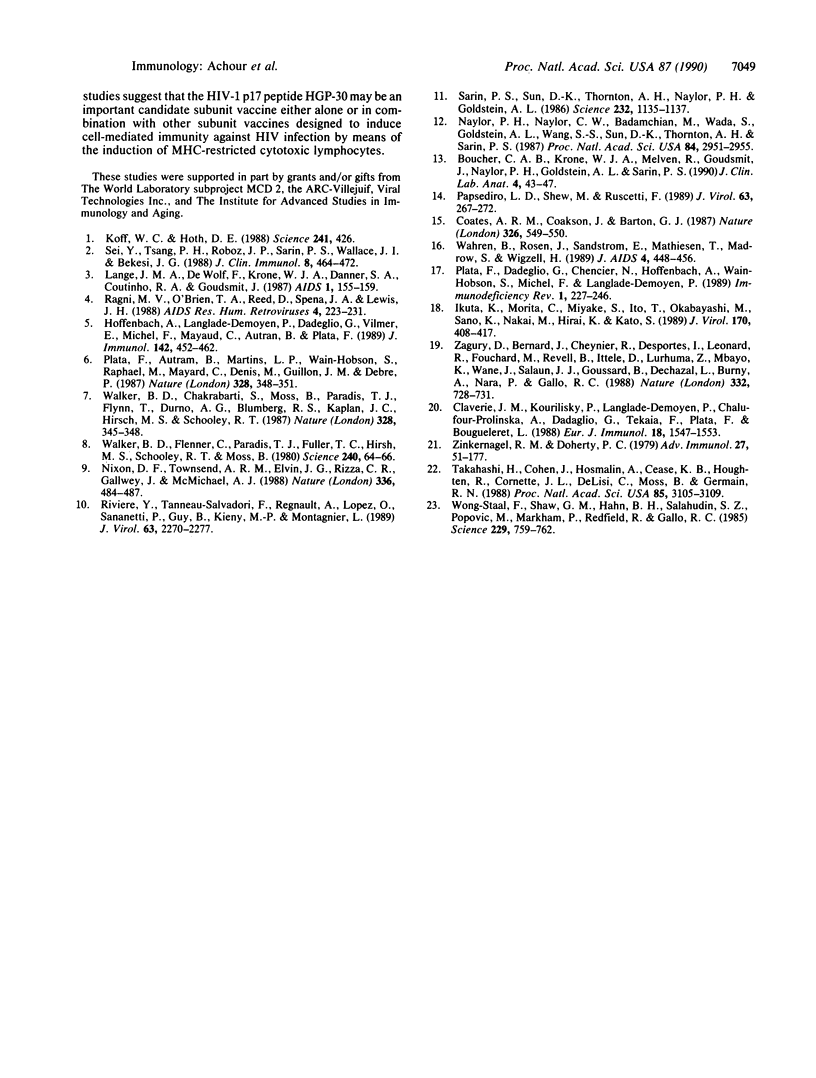
Images in this article
Selected References
These references are in PubMed. This may not be the complete list of references from this article.
- Boucher C. A., Krone W. J., Goudsmit J., Meloen R. H., Naylor P. H., Goldstein A. L., Sun D. K., Sarin P. S. Immune response and epitope mapping of a candidate HIV-1 p17 vaccine HGP30. J Clin Lab Anal. 1990;4(1):43–47. doi: 10.1002/jcla.1860040109. [DOI] [PubMed] [Google Scholar]
- Claverie J. M., Kourilsky P., Langlade-Demoyen P., Chalufour-Prochnicka A., Dadaglio G., Tekaia F., Plata F., Bougueleret L. T-immunogenic peptides are constituted of rare sequence patterns. Use in the identification of T epitopes in the human immunodeficiency virus gag protein. Eur J Immunol. 1988 Oct;18(10):1547–1553. doi: 10.1002/eji.1830181012. [DOI] [PubMed] [Google Scholar]
- Coates A. R., Cookson J., Barton G. J., Zvelebil M. J., Sternberg M. J. AIDS vaccine predictions. Nature. 1987 Apr 9;326(6113):549–550. doi: 10.1038/326549c0. [DOI] [PubMed] [Google Scholar]
- Hoffenbach A., Langlade-Demoyen P., Dadaglio G., Vilmer E., Michel F., Mayaud C., Autran B., Plata F. Unusually high frequencies of HIV-specific cytotoxic T lymphocytes in humans. J Immunol. 1989 Jan 15;142(2):452–462. [PubMed] [Google Scholar]
- Ikuta K., Morita C., Miyake S., Ito T., Okabayashi M., Sano K., Nakai M., Hirai K., Kato S. Expression of human immunodeficiency virus type 1 (HIV-1) gag antigens on the surface of a cell line persistently infected with HIV-1 that highly expresses HIV-1 antigens. Virology. 1989 Jun;170(2):408–417. doi: 10.1016/0042-6822(89)90431-5. [DOI] [PubMed] [Google Scholar]
- Koff W. C., Hoth D. F. Development and testing of AIDS vaccines. Science. 1988 Jul 22;241(4864):426–432. doi: 10.1126/science.3293212. [DOI] [PubMed] [Google Scholar]
- Lange J. M., de Wolf F., Krone W. J., Danner S. A., Coutinho R. A., Goudsmit J. Decline of antibody reactivity to outer viral core protein p17 is an earlier serological marker of disease progression in human immunodeficiency virus infection than anti-p24 decline. AIDS. 1987 Sep;1(3):155–159. [PubMed] [Google Scholar]
- Naylor P. H., Naylor C. W., Badamchian M., Wada S., Goldstein A. L., Wang S. S., Sun D. K., Thornton A. H., Sarin P. S. Human immunodeficiency virus contains an epitope immunoreactive with thymosin alpha 1 and the 30-amino acid synthetic p17 group-specific antigen peptide HGP-30. Proc Natl Acad Sci U S A. 1987 May;84(9):2951–2955. doi: 10.1073/pnas.84.9.2951. [DOI] [PMC free article] [PubMed] [Google Scholar]
- Nixon D. F., Townsend A. R., Elvin J. G., Rizza C. R., Gallwey J., McMichael A. J. HIV-1 gag-specific cytotoxic T lymphocytes defined with recombinant vaccinia virus and synthetic peptides. Nature. 1988 Dec 1;336(6198):484–487. doi: 10.1038/336484a0. [DOI] [PubMed] [Google Scholar]
- Papsidero L. D., Sheu M., Ruscetti F. W. Human immunodeficiency virus type 1-neutralizing monoclonal antibodies which react with p17 core protein: characterization and epitope mapping. J Virol. 1989 Jan;63(1):267–272. doi: 10.1128/jvi.63.1.267-272.1989. [DOI] [PMC free article] [PubMed] [Google Scholar]
- Plata F., Autran B., Martins L. P., Wain-Hobson S., Raphaël M., Mayaud C., Denis M., Guillon J. M., Debré P. AIDS virus-specific cytotoxic T lymphocytes in lung disorders. Nature. 1987 Jul 23;328(6128):348–351. doi: 10.1038/328348a0. [DOI] [PubMed] [Google Scholar]
- Plata F., Dadaglio G., Chenciner N., Hoffenbach A., Wain-Hobson S., Michel F., Langlade-Demoyen P. Cytotoxic T lymphocytes in HIV-induced disease: implications for therapy and vaccination. Immunodefic Rev. 1989;1(3):227–246. [PubMed] [Google Scholar]
- Ragni M. V., O'Brien T. A., Reed D., Spero J. A., Lewis J. H. Prognostic importance of antibodies to human immunodeficiency virus by recombinant immunoassay and Western blot techniques in HIV antibody-positive hemophiliacs. AIDS Res Hum Retroviruses. 1988 Jun;4(3):223–231. doi: 10.1089/aid.1988.4.223. [DOI] [PubMed] [Google Scholar]
- Riviere Y., Tanneau-Salvadori F., Regnault A., Lopez O., Sansonetti P., Guy B., Kieny M. P., Fournel J. J., Montagnier L. Human immunodeficiency virus-specific cytotoxic responses of seropositive individuals: distinct types of effector cells mediate killing of targets expressing gag and env proteins. J Virol. 1989 May;63(5):2270–2277. doi: 10.1128/jvi.63.5.2270-2277.1989. [DOI] [PMC free article] [PubMed] [Google Scholar]
- Sarin P. S., Sun D. K., Thornton A. H., Naylor P. H., Goldstein A. L. Neutralization of HTLV-III/LAV replication by antiserum to thymosin alpha 1. Science. 1986 May 30;232(4754):1135–1137. doi: 10.1126/science.3010464. [DOI] [PubMed] [Google Scholar]
- Sei Y., Tsang P. H., Roboz J. P., Sarin P. S., Wallace J. I., Bekesi J. G. Neutralizing antibodies as a prognostic indicator in the progression of acquired immune deficiency syndrome (AIDS)-related disorders: a double-blind study. J Clin Immunol. 1988 Nov;8(6):464–472. doi: 10.1007/BF00916952. [DOI] [PubMed] [Google Scholar]
- Takahashi H., Cohen J., Hosmalin A., Cease K. B., Houghten R., Cornette J. L., DeLisi C., Moss B., Germain R. N., Berzofsky J. A. An immunodominant epitope of the human immunodeficiency virus envelope glycoprotein gp160 recognized by class I major histocompatibility complex molecule-restricted murine cytotoxic T lymphocytes. Proc Natl Acad Sci U S A. 1988 May;85(9):3105–3109. doi: 10.1073/pnas.85.9.3105. [DOI] [PMC free article] [PubMed] [Google Scholar]
- Wahren B., Rosen J., Sandström E., Mathiesen T., Modrow S., Wigzell H. HIV-1 peptides induce a proliferative response in lymphocytes from infected persons. J Acquir Immune Defic Syndr. 1989;2(5):448–456. [PubMed] [Google Scholar]
- Walker B. D., Chakrabarti S., Moss B., Paradis T. J., Flynn T., Durno A. G., Blumberg R. S., Kaplan J. C., Hirsch M. S., Schooley R. T. HIV-specific cytotoxic T lymphocytes in seropositive individuals. Nature. 1987 Jul 23;328(6128):345–348. doi: 10.1038/328345a0. [DOI] [PubMed] [Google Scholar]
- Walker B. D., Flexner C., Paradis T. J., Fuller T. C., Hirsch M. S., Schooley R. T., Moss B. HIV-1 reverse transcriptase is a target for cytotoxic T lymphocytes in infected individuals. Science. 1988 Apr 1;240(4848):64–66. doi: 10.1126/science.2451288. [DOI] [PubMed] [Google Scholar]
- Wong-Staal F., Shaw G. M., Hahn B. H., Salahuddin S. Z., Popovic M., Markham P., Redfield R., Gallo R. C. Genomic diversity of human T-lymphotropic virus type III (HTLV-III). Science. 1985 Aug 23;229(4715):759–762. doi: 10.1126/science.2992084. [DOI] [PubMed] [Google Scholar]
- Zagury D., Bernard J., Cheynier R., Desportes I., Leonard R., Fouchard M., Reveil B., Ittele D., Lurhuma Z., Mbayo K. A group specific anamnestic immune reaction against HIV-1 induced by a candidate vaccine against AIDS. Nature. 1988 Apr 21;332(6166):728–731. doi: 10.1038/332728a0. [DOI] [PubMed] [Google Scholar]
- Zinkernagel R. M., Doherty P. C. MHC-restricted cytotoxic T cells: studies on the biological role of polymorphic major transplantation antigens determining T-cell restriction-specificity, function, and responsiveness. Adv Immunol. 1979;27:51–177. doi: 10.1016/s0065-2776(08)60262-x. [DOI] [PubMed] [Google Scholar]



